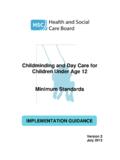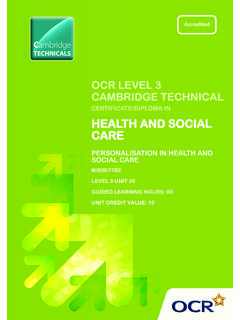Transcription of CERTIFICATE/DIPLOMA IN HEALTH AND SOCIAL …
1 HEALTH AND SOCIAL care SERVICESH/600/6886 LEVEL 2 UNIT 10 GUIDED LEARNING HOURS: 60 UNIT CREDIT VALUE: 10 OCR LEVEL 2 CAMBRIDGE TECHNICALCERTIFICATE/ diploma INHEALTH AND SOCIAL AND SOCIAL care SERVICESH/600/6886 LEVEL 2 UNIT 10 AIM OF THE UNITMany learners will be considering careers within HEALTH and SOCIAL care and this unit introduces them to the different types of service provision available within HEALTH and SOCIAL care . It considers how central government policies impact on local HEALTH and SOCIAL care provision.
2 The unit aims to provide an overview of types of services, barriers which could affect access to services and differing job roles which exist within these services. PURPOSE OF THE UNIT Every service that exists within HEALTH and SOCIAL care belongs to one of four types of provision ie. Statutory, voluntary (third sector), private or informal. Learners will investigate the availability of HEALTH and SOCIAL care services in their local area and identify which services belong to which type of provision. Learners will find out about how decisions made at central government level can impact on local services and affect the type, quality and quantity of services provided.
3 HEALTH and SOCIAL care services are available in each locality and most people are able to use them without any difficulties. However there are reasons why some people are unable to access the services they need, these reasons are known as barriers. Learners will be able to consider the consequences for those individuals who are unable to access services due to cultural, psychological or geographical barriers for is a wide variety of job roles within HEALTH and SOCIAL care and this unit enables students to explore two different job roles and consider the skills and qualities required.
4 They will also evaluate the different ways of training and or qualifying for a certain job role academic and vocational pathways. Learners will gain awareness that rarely do individuals work in isolation within HEALTH or SOCIAL care and this unit will enable them to develop an understanding of partnership and interagency working. Learners will have the opportunity to consider how and why certain practitioners and agencies work within a partnership for the benefit of people who use and SOCIAL care Services Level 2 Unit 101 Know key elements of HEALTH and SOCIAL care services2 Know barriers to accessing HEALTH and SOCIAL care services3 Understand principles of partnership in HEALTH and SOCIAL care 4 Understand requirements for job roles in HEALTH and SOCIAL careP1 identify the key elements of HEALTH and SOCIAL care servicesP2 identify
5 The main barriers to accessing HEALTH and SOCIAL careP3 explain the benefits of interagency partnerships P4 explain the skills required for two different job roles in HEALTH and SOCIAL careM1 describe government policy that affects HEALTH or SOCIAL care servicesM2 describe possible effects of barriers on people who use servicesD1 review a case where effective partnership working could have, or did, affect the outcome for a person who uses HEALTH or SOCIAL care servicesD2 evaluate qualification pathways available for job roles in HEALTH or SOCIAL careASSESSMENT AND GRADING CRITERIAL earning Outcome (LO) Pass Merit Distinction The assessment criteria are To achieve a merit the To achieve a distinction the pass requirements for evidence must show that, the evidence must show this unit.
6 In addition to the pass that, in addition to the pass criteria, the learner is able to: and merit criteria, the The learner will: The learner can: learner is able to: CONTENTThe unit content describes what has to be taught to ensure that learners are able to access the highest which follows an details what must be taught as part of that area of which follows an is illustrative, it should be noted that where is used, learners must know and be able to apply relevant examples to their work though these do not need to be the same ones specified in the unit Know key elements of HEALTH and SOCIAL care services Types of Provision.
7 Statutory, voluntary (third sector), private, informal Organisations involved in HEALTH and SOCIAL care : ( SOCIAL services, NHS; Strategic HEALTH Authorities; NHS Trusts; primary HEALTH care ; secondary healthcare; tertiary HEALTH care ; mental HEALTH trusts; children s trusts) HEALTH and SOCIAL care settings: hospitals, hospices, fostering arrangements, residential homes, day centres, Sure Start, domiciliary support; how different settings provide different services according to need Relevant and current government policy: (eg.)
8 Every Child Matters; Current NHS reforms, Surestart, Children Act; NHS and care in the Community Act: Equality Act). 2 Know barriers to accessing HEALTH and SOCIAL care services Barriers: physical; financial; geographical location; cultural; individual preferences; SOCIAL class; psychological; language/communication. 3 Understand principles of partnership in HEALTH and SOCIAL care Partnership/inter-agency/multi-disciplin ary working ( users of services forums; voluntary and statutory sector liaison; integrated workforce agenda) Purposes/benefits: ( holistic approach; identification of common aims; promotion of integration; reduction of duplication; pooling of resources; maximisation of expertise; ensuring a consistent approach; overcoming barriers).
9 4 Understand requirements for job roles in HEALTH and SOCIAL care Job role requirements of: ( nurse, mental HEALTH nurse, midwife, HEALTH visitor, nursing assistant, doctor, dentist, optician, pharmacist, dietician, paramedic, hospital play worker, occupational therapist, physiotherapist, medical laboratory technician, medical receptionist, cleaner, porter, SOCIAL worker, manager of residential home, care assistant, community workers, mobile meals staff, family support worker, assistant youth worker, counsellor, childminder, nursery nurse, nanny, foster parent, operating department practitioner)
10 care skills and qualities: active support; interpersonal skills; meeting basic needs; maintaining personal hygiene and mobility, appearance/dress, attitude, confidence, punctuality, empathy, ability to work with others; competence Types of qualification or training pathway: (eg. vocational, academic, part-times courses, on the job training, evening classes) Advantages and disadvantages of qualification/training pathways: ( time involved, cost involved, promotion opportunities, work/life balance, life experiences, potential to earn money).


















